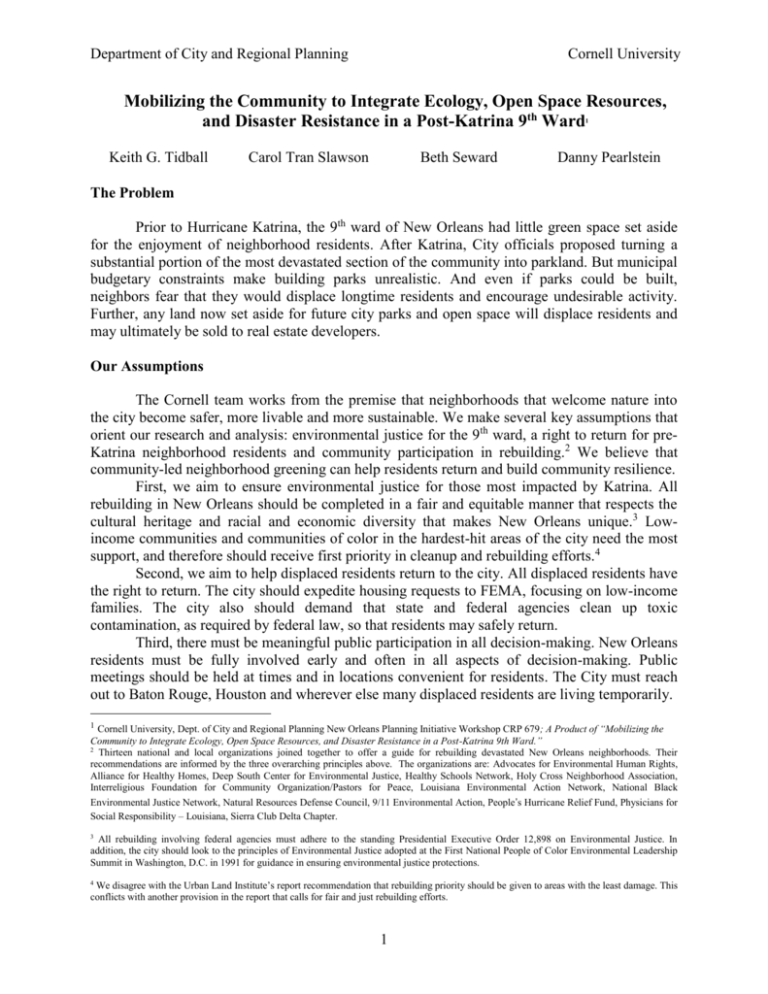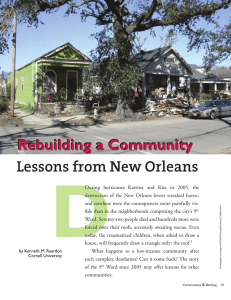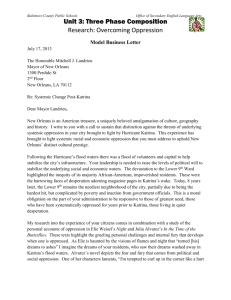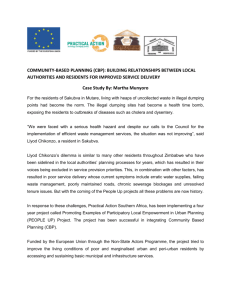CRP_679_Green_Paper_.. - Sci
advertisement

Department of City and Regional Planning Cornell University Mobilizing the Community to Integrate Ecology, Open Space Resources, and Disaster Resistance in a Post-Katrina 9th Ward 1 Keith G. Tidball Carol Tran Slawson Beth Seward Danny Pearlstein The Problem Prior to Hurricane Katrina, the 9th ward of New Orleans had little green space set aside for the enjoyment of neighborhood residents. After Katrina, City officials proposed turning a substantial portion of the most devastated section of the community into parkland. But municipal budgetary constraints make building parks unrealistic. And even if parks could be built, neighbors fear that they would displace longtime residents and encourage undesirable activity. Further, any land now set aside for future city parks and open space will displace residents and may ultimately be sold to real estate developers. Our Assumptions The Cornell team works from the premise that neighborhoods that welcome nature into the city become safer, more livable and more sustainable. We make several key assumptions that orient our research and analysis: environmental justice for the 9th ward, a right to return for preKatrina neighborhood residents and community participation in rebuilding.2 We believe that community-led neighborhood greening can help residents return and build community resilience. First, we aim to ensure environmental justice for those most impacted by Katrina. All rebuilding in New Orleans should be completed in a fair and equitable manner that respects the cultural heritage and racial and economic diversity that makes New Orleans unique.3 Lowincome communities and communities of color in the hardest-hit areas of the city need the most support, and therefore should receive first priority in cleanup and rebuilding efforts.4 Second, we aim to help displaced residents return to the city. All displaced residents have the right to return. The city should expedite housing requests to FEMA, focusing on low-income families. The city also should demand that state and federal agencies clean up toxic contamination, as required by federal law, so that residents may safely return. Third, there must be meaningful public participation in all decision-making. New Orleans residents must be fully involved early and often in all aspects of decision-making. Public meetings should be held at times and in locations convenient for residents. The City must reach out to Baton Rouge, Houston and wherever else many displaced residents are living temporarily. 1 Cornell University, Dept. of City and Regional Planning New Orleans Planning Initiative Workshop CRP 679; A Product of “Mobilizing the Community to Integrate Ecology, Open Space Resources, and Disaster Resistance in a Post-Katrina 9th Ward.” 2 Thirteen national and local organizations joined together to offer a guide for rebuilding devastated New Orleans neighborhoods. Their recommendations are informed by the three overarching principles above. The organizations are: Advocates for Environmental Human Rights, Alliance for Healthy Homes, Deep South Center for Environmental Justice, Healthy Schools Network, Holy Cross Neighborhood Association, Interreligious Foundation for Community Organization/Pastors for Peace, Louisiana Environmental Action Network, National Black Environmental Justice Network, Natural Resources Defense Council, 9/11 Environmental Action, People’s Hurricane Relief Fund, Physicians for Social Responsibility – Louisiana, Sierra Club Delta Chapter. 3 All rebuilding involving federal agencies must adhere to the standing Presidential Executive Order 12,898 on Environmental Justice. In addition, the city should look to the principles of Environmental Justice adopted at the First National People of Color Environmental Leadership Summit in Washington, D.C. in 1991 for guidance in ensuring environmental justice protections. We disagree with the Urban Land Institute’s report recommendation that rebuilding priority should be given to areas with the least damage. This conflicts with another provision in the report that calls for fair and just rebuilding efforts. 4 1 Department of City and Regional Planning Cornell University Big Ideas Community Greening The notion that green spaces are critical components to healthy urban spaces is not new. Ebenezeer Howard described the phenomena in Garden Cities of Tomorrow in 1898. Since then, green space in urban environments, whether created through public works or by individuals and communities, has been a feature of the urban landscape. There are many benefits to individuals, organizations, and communities that can be gained from a green environment. The ability to see or experience green space is reported to have dramatic impacts on individuals, including improved worker productivity, reduction of domestic violence, and quicker healing times. A growing body of literature demonstrates the cognitive and psychological benefits of natural environment experiences. Some recent research has focused on the attentional benefits of nature experiences. Other studies demonstrate the positive effects of natural views on physical health. There are equally compelling findings about individual well being, including stress-reduction, reduced driving frustration and aggression, and neighborhood satisfaction. Green environments can be important to children as well, supporting skills development and cognition, reduced symptoms of Attention Deficit and Hyperactivity Disorder (ADHD), improved school performance and, again, reduced domestic violence. More specific to urban environments, a series of recent studies demonstrates the value of trees and vegetation in urban housing projects, and that vegetation plays an important role in creating a greater sense of connectedness to the community that helps reduce violence. There are benefits of greening activities and green space that accrue to individuals that also have clear benefits to organizations. Workers reported increased productivity when they had green space views from their workplaces, as did their supervisors. Trees make business districts more desirable; potential consumers believe business districts with trees have more desirable goods and services. Community Gardening According to Raquel Pinderhughes of the Urban Studies program at San Francisco State University, there are six broad categories of benefits realized by participants in urban greening activities, especially urban gardening: strengthening the food system, training in nutrition and food preparation, youth skill development and job training, reversing neighborhood blight, environmental protection and community development. Community gardens can vary in size from 5'x5' plots to as much as 25' square plots or larger. Usual sizes are in the 10 x 10 to 15 x 15' range. Community gardens are often run by a self-governing set of bylaws, some elect boards in a democratic fashion while others can be run by appointed officials. Many are run by not-for-profit organizations, such as a community gardening association, a church, or other land-owner. Others are run by a city's recreation or parks department, a school or University. Still others exist as a result of one or two key individuals in a neighborhood. There are many different organizational models in use for community gardens. 2 Department of City and Regional Planning Cornell University Community Forestry Forestry can be included in community planning to create healthy urban and community forests that enhance quality of life for urban residents. Forestry programs can be partnerships between public, private and volunteer organizations. Forestry does not have to mean large tracts of land, but can include street trees, yards, parks, cemeteries, school grounds, and undeveloped green spaces. The New York State Department of Environmental Conservation defines urban and community forestry as the management of community forests to establish and maintain healthy trees for air and water quality benefits, energy savings, environmental health and quality of life for urban residents. Trees provide numerous environmental, social and economic benefits for people. Studies show that trees improve air and water quality, reduce flooding, reduce cooling and heating energy needs, increase property values and improve the quality of life for people around them. According to the United States Forest Service, people are more likely to exercise if trees are nearby. When people utilize green space and shady street trees, they are more likely to meet and establish bonds with their neighbors, and create a sense of community. When people enjoy spending time in their neighborhoods, they develop pride and a sense of ownership in their communities. Civic Agriculture As the 9th Ward is rebuilt and residents return to the area, consideration must be given to food security. The United States Department of Agriculture calls food security access by all people at all times to enough food for an active, healthy life. The community has several options for food security. We highlight both farmers’ markets and supermarkets. In addition, we address recent attention to the EPA’s report on contaminated soil with information from a report by the Natural Resources Defense Council. Locally owned supermarkets support the local economy by providing jobs and tax dollars while connecting more intimately than national chains with community members. For just one instance, New Deal Supermarket, located in Jackson, Mississippi, is a locally owned business that has developed a successful minority-owned and operated supermarket chain. Supermarkets associated with retailers’ cooperatives, like Independent Grocers Alliance (IGA) are also locally-owned and independent. Associated Grocers is an example of a retailerowned company located in Louisiana. This type of business is able to collectively obtain discounts from manufacturers and pools its marketing resources to reduce costs. Consumer-owned cooperatives are member-based organizations in which the members and staff both share ownership in the store for mutual benefit. All profits are returned to the cooperative, rather than to individuals. These stores offer wholesome food at the lowest practical price, which may sometimes mean higher prices associated with specialty goods and small distribution networks. A typical cooperative makes a commitment to serving the following goals: promoting environmental sustainability, offering healthful food and diet, active member involvement, supporting economic and social justice, serving the community. Farmers’ markets are another local option for food production and retailing. A typical market sells locally-grown food directly from farmers to the consumer. Home manufactured goods and local musicians are also featured, which adds a feel for the local culture. This public space can also provide the community a place to gather and communicate issues of concern for residents. Farmers’ markets have been successful in smaller towns and have also been recently 3 Department of City and Regional Planning Cornell University introduced in urban areas. The Anacostia neighborhood of Washington, DC, has many similarities with the 9th Ward: elevated poverty levels, high unemployment and lack of supermarkets. The Anacostia Farmers’ Market was established in 2000 and continues to operate. Some goods that are sold include: local fruit and vegetables, jams and jellies, fresh and dried herbs and fried fish. A recent report called Hot Peppers & Parking Lot Peaches: Evaluating Farmers’ Markets in Low Income Communities and issued by the Community Food Security Coalition identified barriers facing low income consumers. Many of these, such as lack of time available for cooking are similar to those faced by middle income individuals. Other barriers, such as price considerations, lack of transportation and food access are unique to low income communities. The EPA issued a report detailing the condition of soils in New Orleans after the flooding from Hurricane Katrina, which stated that contamination levels in the city pose no “unacceptable" health risks. The NRDC conducted additional testing in November 2005 and issued a warning that contaminant readings found high levels of arsenic, lead, and petroleum compounds across the city at levels that should have triggered a mandatory cleanup or additional investigation. While environmental cleanup from the disaster are still underway, residents can take extra precautions to protect themselves and their families from health risks. Local Cooperative Extension Service provides brochures that explain how to collect samples for soil testing and can help locate the nearest public university offering soil fertility testing at a low cost. In addition, basic measures like immediately washing after contact with soil, cleaning clothes that picked up dust and soil, and cleaning the feet and coat of pets will reduce any risk associated with contaminated soil until the proper restoration measures have been completed. Urban Community Land Trusts Having studied examples from across the United States, our team proposes that ACORN consider establishing an urban community land trust first within the Upper Ninth Ward study area and eventually in other New Orleans neighborhoods and elsewhere as well. Sound neighborhood-building must consider both equity and ecology. Therefore, we propose a blended land trust model that incorporates perpetually affordable housing with community-controlled green space designed to enhance both food security and disaster resistance. We call the model we are proposing an urban community land trust because it blends features of the Trust for Public Land’s (TPL) up-and-coming urban land trust community gardening model and the Institute for Community Economics’ (ICE) thirty-year-old affordable housing community land trust model. Both models are thriving across the country. Our research suggests that New Orleans and ACORN may be the place and the organization to combine the two to maximum effect. The major similarity of trusts for affordable housing and for gardens is that the land is set aside permanently by means of an easement for a particular, public-spirited use and it is owned and stewarded by a third sector organization. In the case of a community land trust, the organization takes title to the land and preserves or builds the residential units. The units themselves may be sold, but the land itself is leased for a long term but remains in the portfolio of the community land trust. Typically, units must be owner-occupied and, when sold, all proceeds beyond a certain dollar amount return to the community land trust. In this way, community land trusts provide the public benefits of affordable housing and accessible homeownership without the risks to the community typically associated with real estate speculation. With a green space land trust, the organization may hold easement rights only while the title to the property itself remains with the original landowner, who is now restricted in using 4 Department of City and Regional Planning Cornell University the land by the terms of the easement. Thus far, the major difference between the two models has been the actual use that land is permanently set aside for. In the case of an urban land trust, vacant lots that have been converted into community gardens are permanently protected as gardens even when real estate markets heat up enough to otherwise convert lots into private residential or commercial buildings. In many U.S. cities, urban land trusts have become particularly popular of late as building booms spread into neighborhoods all but left for dead during the urban fiscal crises of the 1970s. Urban land trusts are a vital tool for keeping neighborhoods ecologically healthy and food secure as property values rise. The Upper Ninth Ward Urban Community Land Trust is a natural outgrowth of and reorganization for the current ACORN Housing program. Post-Katrina, ACORN could purchase previously blighted and adjudicated parcels as well as lots on which owners are choosing not to return and rebuild. Working with the local organization Parkway Partners and national groups including TPL and ICE, ACORN and the new land trust can set aside some plots for gardens and convert others into green-built, disaster-resistant, permanently affordable housing units. Given the urgency of affordable housing availability and the pressure for urban greening motivated by elite organizations like the Urban Land Institute and the Bring New Orleans Back Commission, an urban community land trust that accounts for both equity and ecology can be the keystone of an Upper Ninth Ward revitalized and improved for its long-time residents. Conclusions and Recommendations Neighborhood building means more than rebuilding individual homes. Our research suggests that ACORN and the 9th ward have a unique opportunity to build community resilience by integrating ecology, open space and disaster resistance. In particular, we believe that a sustained effort to green the community with gardens, street trees, civic agriculture and and urban community land trust will produce the long-term benefits that are priorities for ACORN and which neighborhood residents have long deserved. Cultivation of land is an age old, time tested means of ensuring the legitimacy of a land claim. Residents of the 9th Ward can only benefit by bolstering their legitimate claims to land in their neighborhoods through community greening. In doing so, residents will have another tool to quell political and outsider concerns about sustainability, the wisdom of rebuilding, and of commitment to the 9th Ward. Through community greening, the 9th ward can become a vibrant and resilient neighborhood, combatting the twin threats of blight and gentrification. More specifically, we propose that ACORN focus initial efforts on a six to ten block area with Galvez Avenue as its southern border to focus an initial community greening effort in an area of the upper 9th most impacted by Hurricane Katrina and which also hosted a substantial number of blighted and adjudicated properties prior to the storm and flood. Several plots can become community gardens while ACORN preserves and rebuilds nearby housing. Local residents can grow food on their blocks, setting aside portions for themselves and selling other produce in a revitalized St. Roch Market. As the first phase of greening gets underway, we propose a palette of three options for greening the neighborhood as a whole, with gardens either spread throughout, clustered in groups or built near the edges of the upper 9th. We believe that any of the three strategies can produce long-term community benefits, and with the capacity of an urban community land trust, secure the upper 9th ward of New Orleans as a proud, beautiful, healthy and safe neighborhood for generations to come. 5







